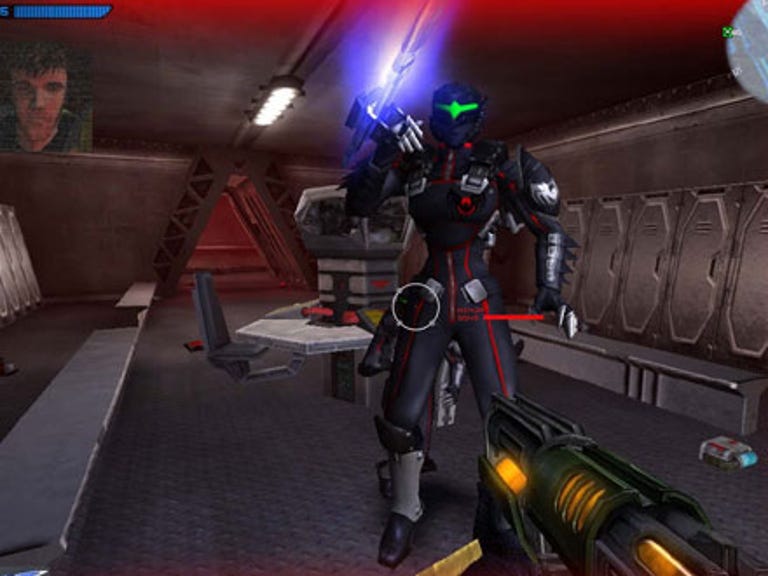 Why You Can Trust CNET
Why You Can Trust CNET Tribes: Vengeance review: Tribes: Vengeance
Fans of the Tribes series will love this game, but newcomers may struggle with some of the controls.
First, a little history. Tribes began as Starsiege: Tribes* in 1998, an ambitious multiplayer squad-based FPS that was developed by Dynamix under the Sierra umbrella. While Starsiege: Tribes was never a large commercial success, it was well received critically and earned itself a loyal band of followers. The follow-up, Tribes 2, was released in 2001 and again succeeded as a solid, fast-paced multiplayer FPS that consolidated its existing fanbase and, just like the original, sold respectable numbers but was shadowed by the bigger titles of its time. Sierra closed the doors to Dynamix later that same year and then went on to cancel the anticipated Tribes 2: Fast Attack, which, amongst other things, was to introduce the first ever single player campaign to the game.
The Good
The Bad
The Bottom Line
Fast forward to 2004 where the Tribes mantle has been passed to the Canberra office of Irrational Games, developers of System Shock 2 and Freedom Force. Breaking off from Looking Glass Studios in 1997, Irrational have an admirable, if short, history of delivering well-polished, entertaining games and Vengeance is no exception; it certainly lives up to the quality of the franchise and will hopefully bring Tribes the mainstream success it deserves. Just how well did they deliver? Well, Sierra are certainly sharing the love: Irrational are now well into the development of the latest installment of the popular SWAT franchise, tentatively scheduled for Q1 2005.
Tribes: Vengeance takes place many years prior to the events of the original Tribes. You play through a number of characters and time periods, predominately the naive Princess Victoria and her precocious daughter Julia some 20 years later. The story weaves, at times predictably, through a web of political machinations and personal vendettas involving the Imperial Royals, and the Red Eagle and Phoenix tribals -- the lines of good and evil are markedly ambiguous with insular character motivations that have far-reaching consequences.
Vengeance's gameplay delivers exactly what it sets out to: an extremely fast-paced, tactical shooter that utilises the extra dimension of flight to shake up the gaming dynamics. Flying is achieved via a jet-pack that can be used in finite-length bursts that recharge automatically when not in use. In addition, your warrior can enable 'frictionless boots', allowing you to 'ski' down inclines and across any surface.Your movement and speed will be entirely guided by whatever momentum you've gathered and, when used in conjunction with flying, grappling, or 'catapult' launches, you can quickly move about the vast, expansive maps. It's a lot of fun when used properly, and you'll find yourself analysing the terrain to determine the best way to make the most of it. However, although effort has been made to simplify the flight and skiing process from past iterations, novices will find this an extremely difficult style of play to master, especially in the middle of a fight.
Other key features include inventory stations, which are generally located near your home base, and provide you with an interface to equip yourself with enhancement packs and differing suits which balance a trade-off between speed vs protective armour, as well as deployable kits, mines and sentry turrets. And while there are no bots in multiplayer matches, the AI in the single player is decent if unremarkable. There are a small number of vehicles, some of which, like Battlefield 1942, can house more than one player; the assault ship, for example, allows you to pilot while up to two gunners rain death from above.
The multiplayer matches in Vengeance, the core strength of the series, are typically arena-style. They range from capturing the flag, to straight-forward elimination rounds. One inventive premise is the 'fuel drop' match where your team aims to collect as many fuel rods as possible, or steal them from the enemy fuel depot.
Graphically, Vengeance makes good use of the Unreal engine with highly detailed maps and structures, far-seeing draw distances, and slick character models - with the exception of Julia's creepy eyes that border on ghoulish. Colours are strong and vibrant - often the only indicator as to who is your enemy - and the world has a dilapidated feel to it that hints at turmoil from within. The 'rag doll' physics engine is used to good effect on encumbered warriors - they'll be literally flung away when hit by close-proximity explosions, and collapse into a heap when killed. The exceptionally morbid of you will want to keep shooting long after death just to watch the limp corpses writhe about, but hey, it's just a game.
Forget the bogged realism of Call of Duty or Conflict Vietnam; Tribes: Vengeance is all about big guns, big mecha suits, and big explosions. If you're after some intense fighting with gung-ho madness, then it's good to get some Vengeance.
* Okay, so technically Tribes: Vengeance is the 12th title set in this particular universe; however, it is the third game release of the unique 'Tribes' playing style, as well as the sequel to Tribes 2, marking it well and truly as the third in the series. So back off.
